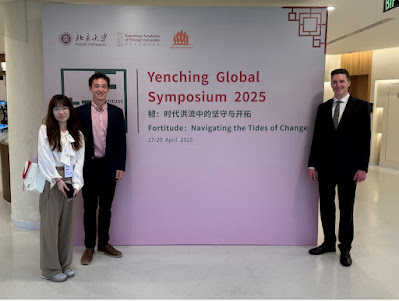Exploring Nanjing: A Visit to the Jiangsu Art Museum 江苏省美术馆
It can sometimes be challenging to find the time to explore and get out into the city of Nanjing while busy with school activities and studying for classes. That’s why I took advantage of the last week of our long Chinese New Year holiday to dedicate some time exploring new parts of the city. I’d heard great things about the Jiangsu Art Museum from both teachers and classmates so I hopped on the subway with a friend and we made our way over.
The Jiangsu Art Museum is located in the heart of the city, only three subway stops away from the Hopkins-Nanjing Center and right next the enormous and also well worth-visiting Nanjing Library. The Nanjing Library is closer in size to a shopping mall and its impressive modern architecture makes it impossible to miss. Arriving at the Jiangsu Art Museum, we were pleasantly surprised to discover that entrance is free to everyone.
The museum is a vast, multi-story building but only a select number of galleries are open at a particular time. I recommend asking which floors and galleries are open ahead of time so you know where to go and what to see. A schedule of different artists and openings is also available on the museum’s website.
I’ve personally never had a very discerning eye for fine art, so my main goal in visiting was to get some exposure to modern Chinese artists and explore one of Nanjing’s famous museums. Fortunately for me, the main gallery that was open that day featured renowned Chinese calligraphists from the late 20th century. Since moving to Nanjing I started taking classes in 笔画, which is basically Chinese hand-writing, a step below calligraphy in terms of sophistication but, as my 老师 tells me, 笔画is a necessary foundation to learning to write with a brush. The gallery exhibit was a great opportunity to see works of some of China’s most renowned calligraphists and gain a deeper appreciation for the skill and finesse that goes into 书法.
While making our way through the gallery, we paused at many of the couplets, trying to think of viable English translations. Since many of the pieces were written in highly stylized script, or using classical Chinese (文言文), this presented some new challenges not found in most readings assigned in class. Though classroom experience at the HNC has been an invaluable part of my education here in China, I highly recommend the many diverse learning opportunities offered by life in Nanjing, a city with a vibrant culture and countless places to explore.
江苏省美术馆欢迎参观!
Written by Amanda Bogan, HNC Certificate '17
The Jiangsu Art Museum is located in the heart of the city, only three subway stops away from the Hopkins-Nanjing Center and right next the enormous and also well worth-visiting Nanjing Library. The Nanjing Library is closer in size to a shopping mall and its impressive modern architecture makes it impossible to miss. Arriving at the Jiangsu Art Museum, we were pleasantly surprised to discover that entrance is free to everyone.
The museum is a vast, multi-story building but only a select number of galleries are open at a particular time. I recommend asking which floors and galleries are open ahead of time so you know where to go and what to see. A schedule of different artists and openings is also available on the museum’s website.
I’ve personally never had a very discerning eye for fine art, so my main goal in visiting was to get some exposure to modern Chinese artists and explore one of Nanjing’s famous museums. Fortunately for me, the main gallery that was open that day featured renowned Chinese calligraphists from the late 20th century. Since moving to Nanjing I started taking classes in 笔画, which is basically Chinese hand-writing, a step below calligraphy in terms of sophistication but, as my 老师 tells me, 笔画is a necessary foundation to learning to write with a brush. The gallery exhibit was a great opportunity to see works of some of China’s most renowned calligraphists and gain a deeper appreciation for the skill and finesse that goes into 书法.
While making our way through the gallery, we paused at many of the couplets, trying to think of viable English translations. Since many of the pieces were written in highly stylized script, or using classical Chinese (文言文), this presented some new challenges not found in most readings assigned in class. Though classroom experience at the HNC has been an invaluable part of my education here in China, I highly recommend the many diverse learning opportunities offered by life in Nanjing, a city with a vibrant culture and countless places to explore.
江苏省美术馆欢迎参观!
Written by Amanda Bogan, HNC Certificate '17




